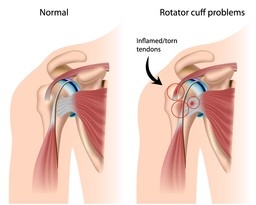

What are the rotator cuff muscles, and what do they do?
The rotator cuff is a group of four muscles: the supraspinatus, the infraspinatus, the subscapularis and the teres minor. These muscles originate on the shoulder blade and attach to the humeral head. Individually, these muscles either internally or externally rotate the humerus. Most commonly however, this group of muscles co-contracts and applies a compressive, stabilizing force to the shoulder. This allows the arm and hand to perform everything from reaching for our coffee cup in the morning to throwing a baseball at 100mph.
What is the mechanism of injury?
 The cause of rotator cuff tears can be divided into two categories: traumatic injury and repetitive motion/overuse. Traumatic injury is usually a onetime event, such as falling on an outstretched arm or trying to catch something heavy from falling, resulting in a traction type of tear. Repetitive motion/overuse tear occurs when a particular motion is performed repetitively, especially repetitive overhead motions. Over time, the rotator cuff muscles may weaken and tear. This may occur due to improper technique of the motion, muscle fatigue, or abnormal muscle substitution patterns during exercise or work. Sometimes an abnormal anatomical feature such as a bone spur on the acromion, or a flattened clavicle may cause impingement and eventual degeneration of a rotator cuff muscle.
The cause of rotator cuff tears can be divided into two categories: traumatic injury and repetitive motion/overuse. Traumatic injury is usually a onetime event, such as falling on an outstretched arm or trying to catch something heavy from falling, resulting in a traction type of tear. Repetitive motion/overuse tear occurs when a particular motion is performed repetitively, especially repetitive overhead motions. Over time, the rotator cuff muscles may weaken and tear. This may occur due to improper technique of the motion, muscle fatigue, or abnormal muscle substitution patterns during exercise or work. Sometimes an abnormal anatomical feature such as a bone spur on the acromion, or a flattened clavicle may cause impingement and eventual degeneration of a rotator cuff muscle.
What are the signs and symptoms of a rotator cuff tear?
One common sign is feeling a sudden, sharp “pop” or pull in the shoulder, followed by pain. This pain may start in the back of the shoulder, then radiate to the biceps and/or the deltoid (side of the shoulder), or up the side of the neck. The pain may be sharp initially, and become like a dull tooth ache like pain as time progresses. There may be general arm weakness and pain with most motions. It may also become difficult or impossible to lift the arm up over one’s head, or reach behind your back. Daily activities such as dressing and driving may also cause pain. People with rotator cuff tears often times have trouble sleeping at night due to pain, especially trying to sleep on the affected shoulder.
Diagnosis and Treatment Options
A thorough physical exam performed by an orthopedic doctor will point to a suspected rotator cuff tear. Diagnostic testing such as a MRI or CAT scan are usually used to confirm the presence of a rotator cuff tear. A conservative course of treatment is usually tried before surgery is suggested. This conservative treatment should consist of a comprehensive physical therapy program that focuses on increasing range of motion, and progressive strengthening of the shoulder complex (the rotator cuff muscles, deltoid, back, and scapular muscles). Ice and anti-inflammatory medications may also help control the pain and inflammation in the shoulder.
If the conservative treatments are ineffective, surgery is usually recommended. Most shoulder surgeries can be performed arthroscopically, minimizing scaring and trauma to surrounding structures. This will lead to a faster and more complete recovery. After surgery, a course of physical therapy is usually prescribed to help restore strength and function. A qualified orthopedic surgeon will review your options and help you make an informed decision that is best for you.
Copyright © www.orthopaedics.win Bone Health All Rights Reserved